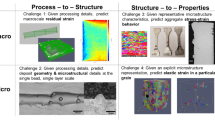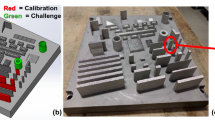Abstract
The Air Force Research Laboratory Additive Manufacturing Modeling Series was executed to create calibration and validation data sets relevant to models of laser powder bed fusion-processed metallic materials. This article describes the data generated for the 2nd of 4 challenge questions which was specifically focused on microscale process-to-structure modeling needs. This work describes the experimental methods, and the resulting characterization data collected from a series of single-track and multi-track deposits built with an EOS M280 from the nickel-based alloy IN625. In general, track dimensions followed common scaling behaviors as a function of processing parameters in quasi-steady-state regions, but significant systematic track geometry variations were quantified in transient regions with more dynamic energy input processes.















Similar content being viewed by others
Data Availability
All of the data described above for calibration and validation data sets in both raw and reduced form have been published at the Materials Data Facility [23, 24], specifically at Ref. [25]. The supplementary information to this article includes a “Data Manifest” document which describes the directory structure, file naming convention, and additional details of the files.
References
Groeber M, Schwalbach E, Musinski W, Shade P, Donegan S, Uchic M, Daniel S, Turner T, Miller J (2018) A preview of the US air force research laboratory additive manufacturing modeling challenge series. JOM 70:441–444. https://doi.org/10.1007/s11837-018-2806-3
Cox ME, Schwalbach EJ, Blaiszik BJ, Groeber MA (2021) AFRL additive manufacturing modeling series: overview. Integr Mater Manuf Innov. https://doi.org/10.1007/s40192-021-00215-6
Chuang AC, Park J-S, Shade PA, Schwalbach EJ, Groeber MA, and Musinski WD AFRL additive manufacturing modeling series: challenge 1, characterization of residual strain distribution in additively-manufactured metal parts using energy dispersive diffraction. Integr Mater Manuf Innov (In Review)
Musinski W, Blosser P, Torbet C, Schwalbach E, Chapman M, Donegan S, Pollock T, and Groeber M AFRL additive manufacturing modeling series: challenge 3, room temperature testing of additively-manufactured Inconel 625 under a range of microstructural and specimen configurations. Integr Mater Manuf Innov (In Review)
Chapman MG, Shah MN, Donegan SP, Scott JM, Shade PA, Menasche D, Uchic MD (2021) AFRL additive manufacturing modeling series: challenge 4, 3D reconstruction of an IN625 high-energy diffraction microscopy sample using multi-modal serial sectioning. Integr Mater Manuf Innov 10:111. https://doi.org/10.1007/s40192-021-00212-9
Menasche DB, Musinski WD, Obstalecki M, Shah MN, Donegan SP, Bernier JV, Kenesei P, Park J-S and Shade PA (2021) AFRL additive manufacturing modeling series: challenge 4, in situ mechanical test of an IN625 sample with concurrent high-energy diffraction microscopy characterization. Integr Mater Manuf Innov. https://doi.org/10.1007/s40192-021-00218-3
Montgomery C, Beuth J, Sheridan L and Klingbeil N Process mapping of Inconel 625 in laser powder bed additive manufacturing. In:Solid freeform fabrication proceedings 2015. Austin, TX. http://utw10945.utweb.utexas.edu/sites/default/files/2015/2015-97-Montgomery.pdf. Accessed 21 Jun 2021
Gong H, Rafi K, Gu H, Starr T, Stucker B (2014) Analysis of defect generation in Ti–6Al–4V parts made using powder bed fusion additive manufacturing processes. Addit Manuf 1–4:87–98. https://doi.org/10.1016/j.addma.2014.08.002
Poulin JR, Brailovski V, Terriault P (2018) Long fatigue crack propagation behavior of Inconel 625 processed by laser powder bed fusion: influence of build orientation and post-processing conditions. Int J Fatigue 116(July):634–647. https://doi.org/10.1016/j.ijfatigue.2018.07.008
Poulin JR, Kreitcberg A, Terriault P, Brailovski V (2019) Long fatigue crack propagation behavior of laser powder bed-fused inconel 625 with intentionally-seeded porosity. Int J Fatigue 127(June):144–156. https://doi.org/10.1016/j.ijfatigue.2019.06.008
Heigel JC, Lane BM (2018) Measurement of the melt pool length during single scan tracks in a commercial laser powder bed fusion process. J Manuf Sci Eng 140(5):051012. https://doi.org/10.1115/1.4037571
Heigel J, Lane B, Levine L, Phan T, Whiting J (2020) Thermography of the metal bridge structures fabricated for the 2018 additive manufacturing benchmark test series (AMBench 2018). J Res Nat Inst Stand Technol 125:125005. https://doi.org/10.6028/jres.125.005
Lane B, Heigel J, Ricker R, Zhirnov I, Khromschenko V, Weaver J, Phan T, Stoudt M, Mekhontsev S, Levine L (2020) Measurements of melt pool geometry and cooling rates of individual laser traces on IN625 bare plates. Integr Mater Manuf Innov 9:16–30. https://doi.org/10.1007/s40192-020-00169-1
Masoomi M, Gao X, Thompson SM, Shamsaei N, Bian L, and Elwany A (2015) Modeling, simulation and experimental validation of heat transfer during selective laser melting. In: Proceedings of the ASME 2015 international mechanical engineering congress and exposition. Houston, TX. https://doi.org/10.1115/IMECE2015-52165
ISO/ASTM (2013) 52921: Standard terminology for additive manufacturing - coordinate systems and test methodologies, ISO/ASTM International
Tang M, Pistorius P, Beuth J (2017) Prediction of lack-of-fusion porosity for powder bed fusion. Addit Manuf 14:39–48. https://doi.org/10.1016/j.addma.2016.12.001
Schindelin J, Arganda-Carreras I, Frise E, Kaynig V, Longair M, Pietzsch T, Preibisch S, Rueden C, Saalfeld S, Schmid B, Tinevez J-Y, White D, Hartenstein V, Eliceiri K, Tomancak P, Cardona A (2012) Fiji: an open-source platform for biological-image analysis. Nat Methods 9:676–682. https://doi.org/10.1038/nmeth.2019
Uchic M, Groeber M, Shah M, Callahan P, Shiveley A, Scott M, Chapman M and Spowart J (2016) An automated multi-modal serial sectioning system for characterization of grain-scale microstructures in engineering materials. In: Proceedings of the 1st international conference on 3D materials science. https://doi.org/10.1007/978-3-319-48762-5_30
Rubenchik A, King W, Wu S (2018) Scaling laws for the additive manufacturing. J Mater Process Technol 257:234–243. https://doi.org/10.1016/j.jmatprotec.2018.02.034
Trapp J, Rubenchik A, Guss G, Matthews M (2017) In situ absorptivity measurements of metallic powders during laser powder-bed fusion additive manufacturing. Appl Mater Today 9(Suppl. C):341–349. https://doi.org/10.1016/j.apmt.2017.08.006
Lowe DG (2006) Distinctive image features from scale-invariant keypoints. Int J Comput Vis 60:91–110. https://doi.org/10.1023/B:VISI.0000029664.99615.94
Ostu N (1979) A threshold selection method from gray-level histograms. IEEE Trans Syst Man Cybern 9(1):62–66. https://doi.org/10.1109/TSMC.1979.4310076
Blaiszik B, Chard K, Pruyne J, Ananthakrishnan R, Tuecke S, Foster I (2016) The materials data facility: data services to advance materials science research. JOM 68(8):2045–2052. https://doi.org/10.1007/s11837-016-2001-3
Blaiszik B, Ward L, Schwarting M, Gaff J, Chard R, Pike D, Chard K, Foster I (2019) A data ecosystem to support machine learning in materials science. MRS Commun. https://doi.org/10.1557/mrc.2019.118
Groeber M, Schwalbach E, Donegan S, Uchic M, Chapman M, Shade P, Musinski W, Miller J, Turner T, Sparkman D and Cox M AFRL AM modeling challenge series: challenge 2 data package. https://doi.org/10.18126/M27H1Z
Schwalbach EJ, Donegan SP, Chapman MG, Chaput KJ, Groeber MA (2019) A discrete source model of powder bed fusion additive manufacturing thermal history. Addit Manuf 25:485–498. https://doi.org/10.1016/j.addma.2018.12.004
Martin AA, Calta NP, Khairallah SA, Wang J, Depond PJ, Fong AY, Thampy V, Guss GM, Kiss AM, Stone KH, Tassone CJ, Weker JN, Toney MF, van Buuren T (2019) Dynamics of pore formation during laser powder bed fusion additive manufacturing. Nat Commun 10:1987. https://doi.org/10.1038/s41467-019-10009-2
Zhang Y, Chen Y, Li P, Male AT (2003) Weld deposition-based rapid prototyping: a preliminary study. J Mater Process Technol 135:347–357. https://doi.org/10.1016/S0924-0136(02)00867-1
Khairallah S, Martin A, Lee J, Guss G, Calta N, Hammons J, Nielsen M, Chaput K, Schwalbach E, Shah M, Chapman M, Willey T, Rubenchik A, Anderson A, Wang Y, Matthews M, King W (2020) Controlling interdependent meso-nanosecond dynamics and defect generation in metal 3D printing. Science 368(6491):660–665. https://doi.org/10.1126/science.aay7830
Acknowledgements
We wish to acknowledge Kevin Cwiok for his assistance in preparation and execution of specimen fabrication; Michael Uchic and Sean Donegan for fruitful discussions regarding the details of the sectioning as well as optical and electron imaging experiments; Paul Wittmann for key-point identification in the single- and multi-track cross section image set, E. Begum Gulsoy, Ben Blaiszik, James Fourman and Matt Jacobsen for assistance in data curation; Marie Cox as the program manager for the AFRL AMMC effort; and the AFRL AMMC team at large.
Author information
Authors and Affiliations
Corresponding author
Additional information
Publisher's Note
Springer Nature remains neutral with regard to jurisdictional claims in published maps and institutional affiliations.
Supplementary Information
Below is the link to the electronic supplementary material.
Rights and permissions
About this article
Cite this article
Schwalbach, E.J., Chapman, M.G. & Groeber, M.A. AFRL Additive Manufacturing Modeling Series: Challenge 2, Microscale Process-to-Structure Data Description. Integr Mater Manuf Innov 10, 319–337 (2021). https://doi.org/10.1007/s40192-021-00220-9
Received:
Accepted:
Published:
Issue Date:
DOI: https://doi.org/10.1007/s40192-021-00220-9




